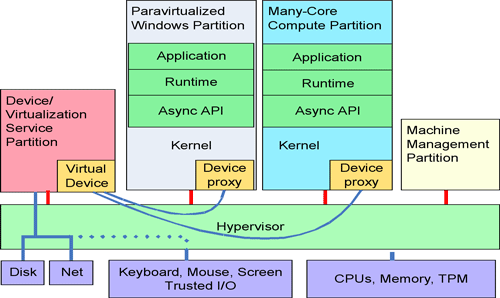Many core operating systems will incorporate a hypervisor, a small and very reliable component that hosts many different operating systems (or copies of the same OS with different performance or security characteristics). Hypervisors perform the relatively slowly change in "space sharing" of resources. For example, a hypervisor might simultaneously dedicate a core for long periods of time to a multimedia OS partition/application combination and assign I/O devices to it, host an older, buggier version of an OS for compatibility, host a tightly controlled corporate partition, host a game partition requiring strong performance guarantees, and host a loosely controlled partition for web browsing on the same hardware. Each partition can be sure of both performance and security isolation, and one partition need not incur the performance, fragility or security characteristics of another.

A many-core system stack (hypervisor, OS kernel, user mode run-time) must effectively assign resources securely and host concurrent operating environments. Machine-wide and OS health (root-kit detection, OS stuck), power management and coarse hardware resource allocation can be managed centrally while insulating partitions from harmful effects of other partitions. As with other software decomposition strategies, this simplifies software construction. Coarse partitioning also provides a good way to get coarse parallelism. Applications running concurrently in separate trust domains need the benefits of either rich operating environments or specialized environments that provide specific guarantees (such as real time scheduling). This also provides a vehicle to stage new facilities while retaining legacy environments unmodified. Each OS partition can exercise finer resource control over the resources it controls in conjunction with its application mix. Within a process, the application and supporting runtime can exert very fine grain control over resources in conjunction with the OS. Further, the OS must include a better asynchronous "system API" and lightweight native threads. Finally, the system stack must manage heterogeneous hardware; general purpose cores, GPUs, vector units and special cores such as encryption or compression.






